DeLaval 874863 In place reader IPR (RFID Transponder Reader User Manual
DeLaval International AB In place reader IPR (RFID Transponder Reader Users Manual
DeLaval >
Users Manual
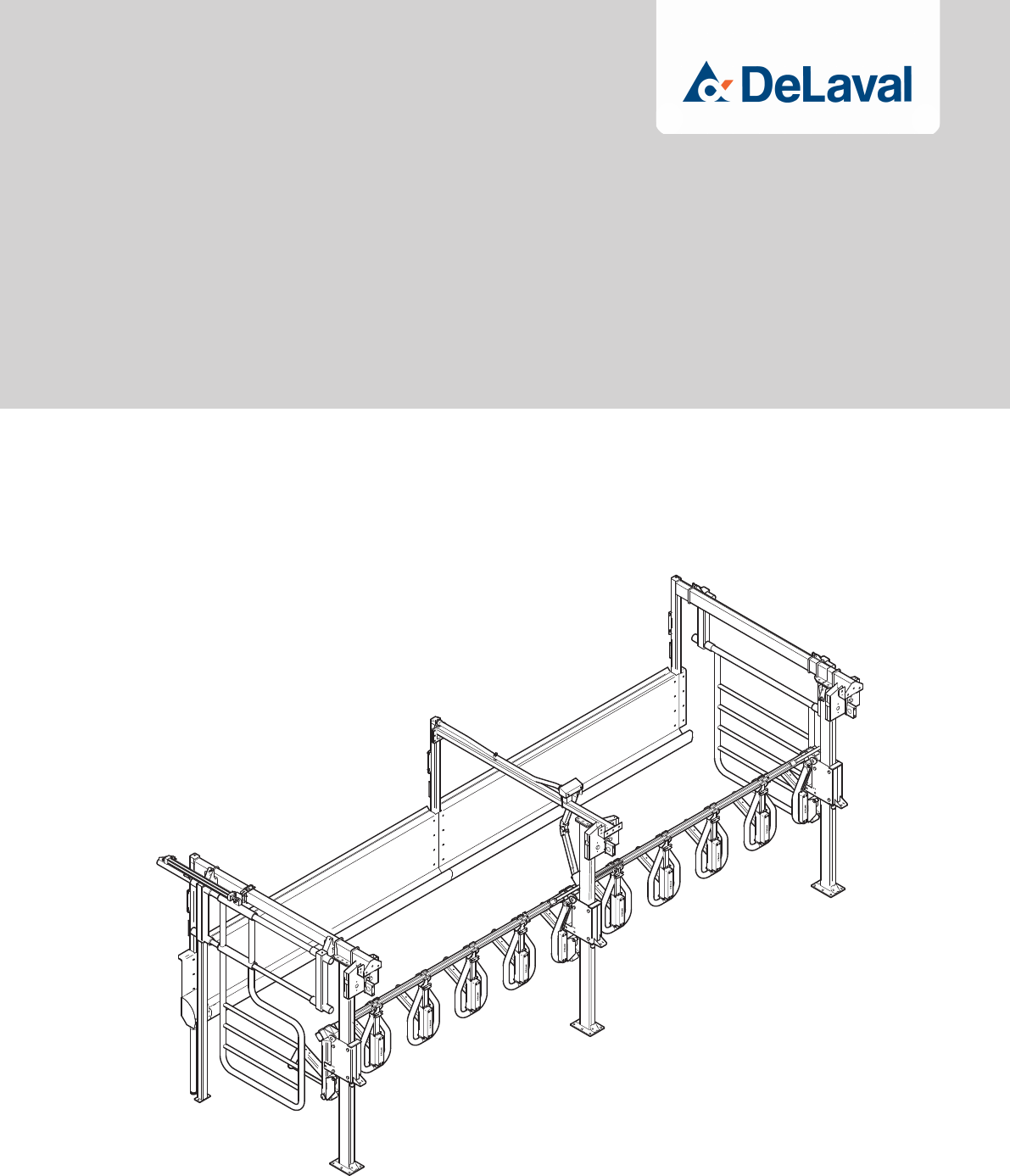
Preliminary
941322_VMS Instruction Book 2006.pdf2009-09-07
No. Name Range Default Description/optionsNo. Name Range Default Description/options
0 = no acidic cleaning0 = no acidic cleaning
1 = one alkaline, one acidic cleaning1 = one alkaline, one acidic cleaning
2 = two alkaline, one acidic cleaning2 = two alkaline, one acidic cleaning
3 = etc.3 = etc.
Maintenance an calibration
The following points are important to sustain
correct dosing of etergents. Note that
these two tasks should be performed by an
authorised DeLaval service engineer.
•The tubes in the peristaltic pumps should
be replaced at least two times a year.
•The dosing volume (P6-P8) of the
detergent pumps should be checked
every third month. The dosing capacity
(P32-P34) may need to be adjusted.
Starting cleaning or rinsing
from the touch screen
Note: Any ongoing backflush process must
first be finished before cleaning or rinsing
can be started.
1. Ensure that the milking station is in
manual mode.
2. Remove any cow that might be in the
milking station.
After treatment window
Note: Both gates should be closed to
prevent a cow from entering before the
system cleaning has been started. Closing
and opening gates is done in the Stall
control window.
3. Press the tab After Treatment on the
touch screen to display the After treatment
window.
4. In the After treatment window, press the
Cleaning and Rinsing button. This will open
the Cleaning and rinsing window.
DeLaval Champion ID
Instruction Book
© DeLaval 2016. 85417601
2016-09-14, Version 9 Original instruction
Preliminary
941322_VMS Instruction Book 2006.pdf2009-09-07
No. Name Range Default Description/optionsNo. Name Range Default Description/options
0 = no acidic cleaning0 = no acidic cleaning
1 = one alkaline, one acidic cleaning1 = one alkaline, one acidic cleaning
2 = two alkaline, one acidic cleaning2 = two alkaline, one acidic cleaning
3 = etc.3 = etc.
Maintenance an calibration
The following points are important to sustain
correct dosing of etergents. Note that
these two tasks should be performed by an
authorised DeLaval service engineer.
•The tubes in the peristaltic pumps should
be replaced at least two times a year.
•The dosing volume (P6-P8) of the
detergent pumps should be checked
every third month. The dosing capacity
(P32-P34) may need to be adjusted.
Starting cleaning or rinsing
from the touch screen
Note: Any ongoing backflush process must
first be finished before cleaning or rinsing
can be started.
1. Ensure that the milking station is in
manual mode.
2. Remove any cow that might be in the
milking station.
After treatment window
Note: Both gates should be closed to
prevent a cow from entering before the
system cleaning has been started. Closing
and opening gates is done in the Stall
control window.
3. Press the tab After Treatment on the
touch screen to display the After treatment
window.
4. In the After treatment window, press the
Cleaning and Rinsing button. This will open
the Cleaning and rinsing window.

Preliminary
941322_VMS Instruction Book 2006.pdf2009-09-07
No. Name Range Default Description/optionsNo. Name Range Default Description/options
0 = no acidic cleaning0 = no acidic cleaning
1 = one alkaline, one acidic cleaning1 = one alkaline, one acidic cleaning
2 = two alkaline, one acidic cleaning2 = two alkaline, one acidic cleaning
3 = etc.3 = etc.
Maintenance an calibration
The following points are important to sustain
correct dosing of etergents. Note that
these two tasks should be performed by an
authorised DeLaval service engineer.
•The tubes in the peristaltic pumps should
be replaced at least two times a year.
•The dosing volume (P6-P8) of the
detergent pumps should be checked
every third month. The dosing capacity
(P32-P34) may need to be adjusted.
Starting cleaning or rinsing
from the touch screen
Note: Any ongoing backflush process must
first be finished before cleaning or rinsing
can be started.
1. Ensure that the milking station is in
manual mode.
2. Remove any cow that might be in the
milking station.
After treatment window
Note: Both gates should be closed to
prevent a cow from entering before the
system cleaning has been started. Closing
and opening gates is done in the Stall
control window.
3. Press the tab After Treatment on the
touch screen to display the After treatment
window.
4. In the After treatment window, press the
Cleaning and Rinsing button. This will open
the Cleaning and rinsing window.
EC Declaration of Conformity - DeLaval Champion ID.................................................................... 5
Safety precautions.............................................................................................................................. 7
nDeLaval Champion ID
1 Warnings and cautions...................................................................................................... 7
2 Compliance with national regulations................................................................................ 8
General description............................................................................................................................. 9
nDeLaval Champion ID
1 Very important issues regarding electronic ID.................................................................. 9
1.1 EU markets....................................................................................................... 9
1.2 North American market..................................................................................... 9
2 Introduction..................................................................................................................... 10
2.1 Transponders.................................................................................................. 10
2.2 Walk-by antennas........................................................................................... 10
2.3 Cow place antennas....................................................................................... 12
3 Parlour applications......................................................................................................... 16
4 Main parts....................................................................................................................... 16
Operator's maintenance.................................................................................................................... 17
nDeLaval Champion ID
1 Daily maintenance........................................................................................................... 17
2 Yearly maintenance........................................................................................................ 17
Troubleshooting................................................................................................................................ 18
nDeLaval Champion ID
1 Troubleshooting.............................................................................................................. 18
Disposal.............................................................................................................................................. 21
nDeLaval Champion ID
1 Disposal and recycling information ............................................................................... 21
1.1 Disposal of packaging material....................................................................... 21
1.2 Disposal of electrical and electronic equipment with or without battery.......... 21
DeLaval Champion ID
Table of contents
© DeLaval 2016.
2016-09-14, Version 9 3 (24) 85417601

Preliminary
941322_VMS Instruction Book 2006.pdf2009-09-07
No. Name Range Default Description/optionsNo. Name Range Default Description/options
0 = no acidic cleaning0 = no acidic cleaning
1 = one alkaline, one acidic cleaning1 = one alkaline, one acidic cleaning
2 = two alkaline, one acidic cleaning2 = two alkaline, one acidic cleaning
3 = etc.3 = etc.
Maintenance an calibration
The following points are important to sustain
correct dosing of etergents. Note that
these two tasks should be performed by an
authorised DeLaval service engineer.
•The tubes in the peristaltic pumps should
be replaced at least two times a year.
•The dosing volume (P6-P8) of the
detergent pumps should be checked
every third month. The dosing capacity
(P32-P34) may need to be adjusted.
Starting cleaning or rinsing
from the touch screen
Note: Any ongoing backflush process must
first be finished before cleaning or rinsing
can be started.
1. Ensure that the milking station is in
manual mode.
2. Remove any cow that might be in the
milking station.
After treatment window
Note: Both gates should be closed to
prevent a cow from entering before the
system cleaning has been started. Closing
and opening gates is done in the Stall
control window.
3. Press the tab After Treatment on the
touch screen to display the After treatment
window.
4. In the After treatment window, press the
Cleaning and Rinsing button. This will open
the Cleaning and rinsing window.
DeLaval Champion ID
Table of contents
© DeLaval 2016.
2016-09-14, Version 9 4 (24) 85417601

Preliminary
941322_VMS Instruction Book 2006.pdf2009-09-07
No. Name Range Default Description/optionsNo. Name Range Default Description/options
0 = no acidic cleaning0 = no acidic cleaning
1 = one alkaline, one acidic cleaning1 = one alkaline, one acidic cleaning
2 = two alkaline, one acidic cleaning2 = two alkaline, one acidic cleaning
3 = etc.3 = etc.
Maintenance an calibration
The following points are important to sustain
correct dosing of etergents. Note that
these two tasks should be performed by an
authorised DeLaval service engineer.
•The tubes in the peristaltic pumps should
be replaced at least two times a year.
•The dosing volume (P6-P8) of the
detergent pumps should be checked
every third month. The dosing capacity
(P32-P34) may need to be adjusted.
Starting cleaning or rinsing
from the touch screen
Note: Any ongoing backflush process must
first be finished before cleaning or rinsing
can be started.
1. Ensure that the milking station is in
manual mode.
2. Remove any cow that might be in the
milking station.
After treatment window
Note: Both gates should be closed to
prevent a cow from entering before the
system cleaning has been started. Closing
and opening gates is done in the Stall
control window.
3. Press the tab After Treatment on the
touch screen to display the After treatment
window.
4. In the After treatment window, press the
Cleaning and Rinsing button. This will open
the Cleaning and rinsing window.
EC Declaration of Conformity
Name of product: DeLaval Champion ID
Report No. 80005145
The product complies with requirements of the following directives:
Radio and Telecommunication Terminal Equipment Directive - 99/5/EEC
Electro magnetic compatibility directive - 2004/108/EC
Harmonized standards which have been used or parts thereof:
EN 61000-6-3:2007
EN 61000-6-2:2005
EN 55022:2006
ETSI EN 301 489-3 V1.4.1
ETSI EN 301 489-1 V1.8.1
ETSI EN 300 330-2 V1.3.1
Tumba 2013-02-28 Signed:
Name: Jan Ove Nilsson
Position: Vice President
Department: BA Capital Goods
Contact: Wiveca Sveen
P.O. Box 39
SE 147 21 TUMBA
Sweden
Name and address of manufacturer:
DeLaval International AB
P.O. Box 39
SE 147 21 TUMBA
Sweden
© DeLaval 2016.
2016-09-14, Version 9 5 (24) 85417601

Preliminary
941322_VMS Instruction Book 2006.pdf2009-09-07
No. Name Range Default Description/optionsNo. Name Range Default Description/options
0 = no acidic cleaning0 = no acidic cleaning
1 = one alkaline, one acidic cleaning1 = one alkaline, one acidic cleaning
2 = two alkaline, one acidic cleaning2 = two alkaline, one acidic cleaning
3 = etc.3 = etc.
Maintenance an calibration
The following points are important to sustain
correct dosing of etergents. Note that
these two tasks should be performed by an
authorised DeLaval service engineer.
•The tubes in the peristaltic pumps should
be replaced at least two times a year.
•The dosing volume (P6-P8) of the
detergent pumps should be checked
every third month. The dosing capacity
(P32-P34) may need to be adjusted.
Starting cleaning or rinsing
from the touch screen
Note: Any ongoing backflush process must
first be finished before cleaning or rinsing
can be started.
1. Ensure that the milking station is in
manual mode.
2. Remove any cow that might be in the
milking station.
After treatment window
Note: Both gates should be closed to
prevent a cow from entering before the
system cleaning has been started. Closing
and opening gates is done in the Stall
control window.
3. Press the tab After Treatment on the
touch screen to display the After treatment
window.
4. In the After treatment window, press the
Cleaning and Rinsing button. This will open
the Cleaning and rinsing window.
© DeLaval 2016.
2016-09-14, Version 9 6 (24) 85417601
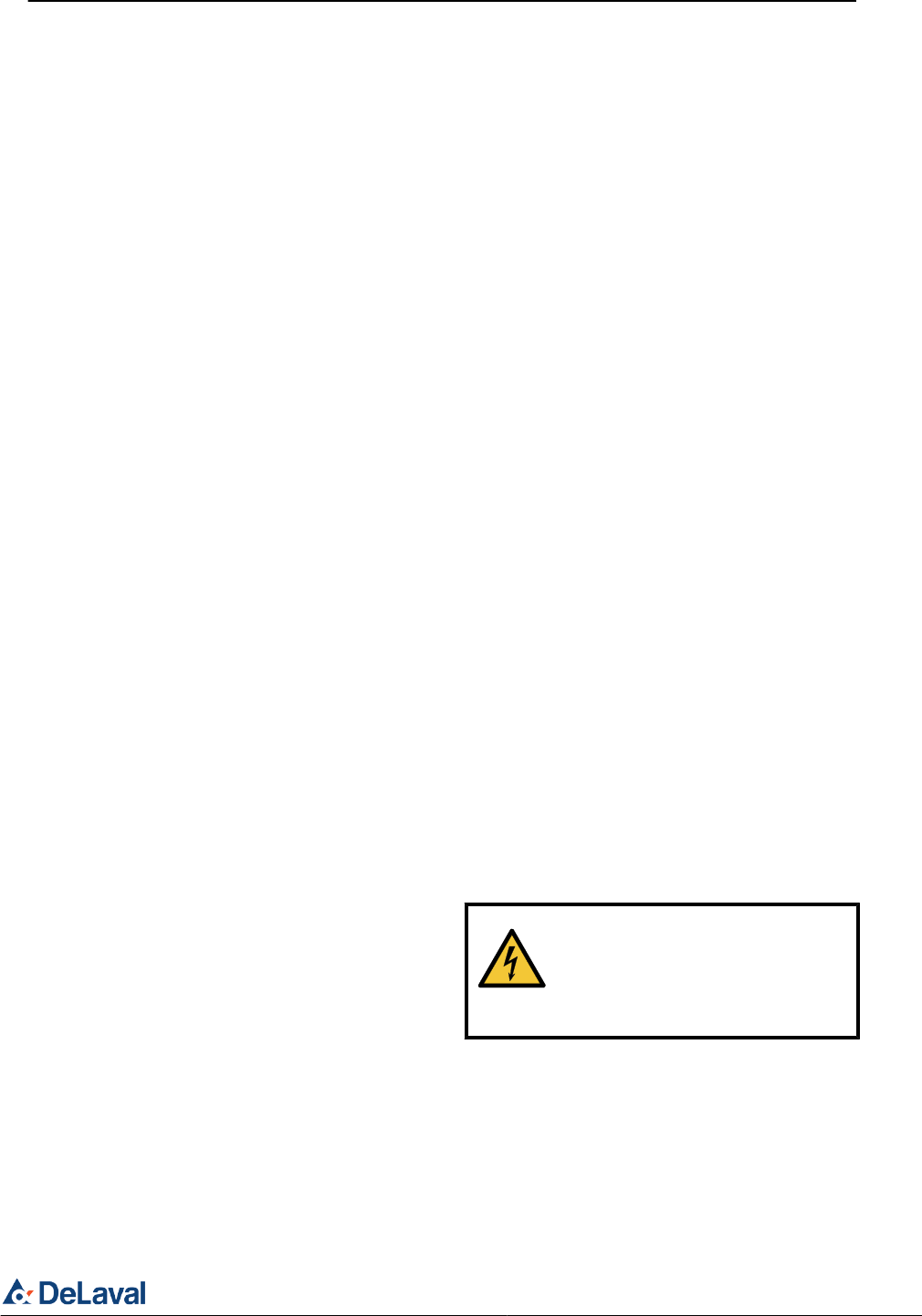
Preliminary
941322_VMS Instruction Book 2006.pdf2009-09-07
No. Name Range Default Description/optionsNo. Name Range Default Description/options
0 = no acidic cleaning0 = no acidic cleaning
1 = one alkaline, one acidic cleaning1 = one alkaline, one acidic cleaning
2 = two alkaline, one acidic cleaning2 = two alkaline, one acidic cleaning
3 = etc.3 = etc.
Maintenance an calibration
The following points are important to sustain
correct dosing of etergents. Note that
these two tasks should be performed by an
authorised DeLaval service engineer.
•The tubes in the peristaltic pumps should
be replaced at least two times a year.
•The dosing volume (P6-P8) of the
detergent pumps should be checked
every third month. The dosing capacity
(P32-P34) may need to be adjusted.
Starting cleaning or rinsing
from the touch screen
Note: Any ongoing backflush process must
first be finished before cleaning or rinsing
can be started.
1. Ensure that the milking station is in
manual mode.
2. Remove any cow that might be in the
milking station.
After treatment window
Note: Both gates should be closed to
prevent a cow from entering before the
system cleaning has been started. Closing
and opening gates is done in the Stall
control window.
3. Press the tab After Treatment on the
touch screen to display the After treatment
window.
4. In the After treatment window, press the
Cleaning and Rinsing button. This will open
the Cleaning and rinsing window.
Safety precautions
DeLaval Champion ID
1 Warnings and cautions
Admonishments are safety related warning mes-
sages.
Admonishments provide important information
that is intended to prevent incorrect or hazardous
use of equipment, machinery or software, and
support risk assessment.
The following list defines the different types used
in DeLaval documentation:
Danger: Refers to imminent and severe risk.
Failure to comply with instruction will result in
serious injury or death.
Warning: Refers to a potential but severe risk.
Failure to comply with instruction could result in
injury or death.
Caution: Refers to a limited risk. Failure to com-
ply with instruction could result in minor injury or
product damage.
Mandatory: Refers to an action or behaviour
which is essential to safe and successful use of
the equipment.
Prohibited: Refers to an action or behaviour
which is incompatible to safe and successful use
of the equipment.
Note! Is intended to draw attention to specific
points of importance in the text.
Warning!
Do not touch the indicated areas - as
they are charged and could give you
an electric shock.
Don't touch:
nHeat sinks
nConnector X20
Definitions of Admonishments
DeLaval Champion ID
Safety precautions
© DeLaval 2016.
2016-09-14, Version 9 7 (24) 85417601
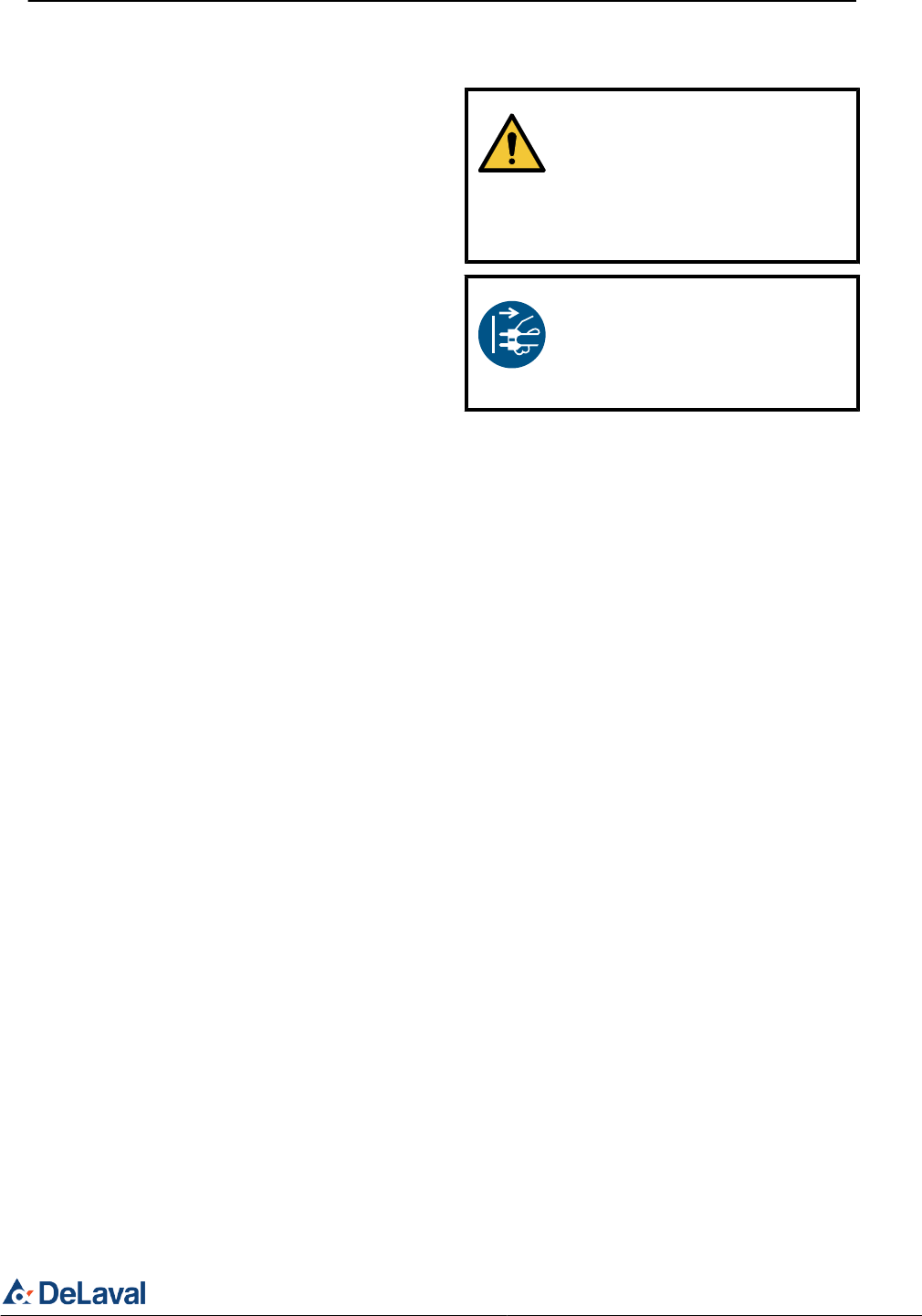
Preliminary
941322_VMS Instruction Book 2006.pdf2009-09-07
No. Name Range Default Description/optionsNo. Name Range Default Description/options
0 = no acidic cleaning0 = no acidic cleaning
1 = one alkaline, one acidic cleaning1 = one alkaline, one acidic cleaning
2 = two alkaline, one acidic cleaning2 = two alkaline, one acidic cleaning
3 = etc.3 = etc.
Maintenance an calibration
The following points are important to sustain
correct dosing of etergents. Note that
these two tasks should be performed by an
authorised DeLaval service engineer.
•The tubes in the peristaltic pumps should
be replaced at least two times a year.
•The dosing volume (P6-P8) of the
detergent pumps should be checked
every third month. The dosing capacity
(P32-P34) may need to be adjusted.
Starting cleaning or rinsing
from the touch screen
Note: Any ongoing backflush process must
first be finished before cleaning or rinsing
can be started.
1. Ensure that the milking station is in
manual mode.
2. Remove any cow that might be in the
milking station.
After treatment window
Note: Both gates should be closed to
prevent a cow from entering before the
system cleaning has been started. Closing
and opening gates is done in the Stall
control window.
3. Press the tab After Treatment on the
touch screen to display the After treatment
window.
4. In the After treatment window, press the
Cleaning and Rinsing button. This will open
the Cleaning and rinsing window.
Caution!
Never clean the equipment with a
high pressure cleaner or any other
jet of water. The equipment is sensi-
tive and can be destroyed by the
high pressure.
Mandatory!
Disconnect the electrical supply
before removing shields, covers or
guards
2 Compliance with national regu-
lations
This device complies with part 15 of the Federal
Communications Commission (FCC) rules and
RSS-210 of the Industry Canada (ICC) rules.
Operation is subject to the following two condi-
tions:
1. This device may not cause harmful inter-
ference.
2. This device must accepts any interference
received, including interferences that may
cause undesired operation.
DeLaval Champion ID
Safety precautions
© DeLaval 2016.
2016-09-14, Version 9 8 (24) 85417601

Preliminary
941322_VMS Instruction Book 2006.pdf2009-09-07
No. Name Range Default Description/optionsNo. Name Range Default Description/options
0 = no acidic cleaning0 = no acidic cleaning
1 = one alkaline, one acidic cleaning1 = one alkaline, one acidic cleaning
2 = two alkaline, one acidic cleaning2 = two alkaline, one acidic cleaning
3 = etc.3 = etc.
Maintenance an calibration
The following points are important to sustain
correct dosing of etergents. Note that
these two tasks should be performed by an
authorised DeLaval service engineer.
•The tubes in the peristaltic pumps should
be replaced at least two times a year.
•The dosing volume (P6-P8) of the
detergent pumps should be checked
every third month. The dosing capacity
(P32-P34) may need to be adjusted.
Starting cleaning or rinsing
from the touch screen
Note: Any ongoing backflush process must
first be finished before cleaning or rinsing
can be started.
1. Ensure that the milking station is in
manual mode.
2. Remove any cow that might be in the
milking station.
After treatment window
Note: Both gates should be closed to
prevent a cow from entering before the
system cleaning has been started. Closing
and opening gates is done in the Stall
control window.
3. Press the tab After Treatment on the
touch screen to display the After treatment
window.
4. In the After treatment window, press the
Cleaning and Rinsing button. This will open
the Cleaning and rinsing window.
General description
DeLaval Champion ID
1 Very important issues regarding
electronic ID
Identification of animals with ISO tags or B trans-
ponders are sensitive to noise. Noise in this case
is radio waves that interfere with the wave length
of the RF transponders. The transponders are
sending in the kHz range.
Variable speed drives (VSD) for electric motors
and electronic ballasts for florescent lights create
noise with a broad wavelength spectrum which
interferes with the reading capabilities of the RF
transponders.
Electric motors that may be driven by VSD can
be found on vacuum pumps, milk pumps, water
pumps, manure pumps, refrigeration pumps,
fans, voluntary milking systems (VMS), as well as
other products that require electric motors
Effects on ID can be very short reading distance
to the readers or transponders or can not be read
at all is the result of this kind of noise.
Acceptable ID performance may not be achieved
if the guidelines below are not followed:
1.1 EU markets
nAccording to EMC standards, filters on all
VSD units driving motors and shielded cables
between the VSD and motor is a demand.
1.2 North American market
nTo help reduce the risk of both noise and
stray voltage, we recommend installing
DeLaval SVF filters on all variable speed
drives, following recommendations in the
DeLaval installation manual, paying close
attention to wire type and conduit type.
nDeLaval SVF filters cannot be used in com-
bination with other filters, such as EMI, RFI,
other internal or external filters.
nFilters must be installed on all florescent
lights having electronic ballasts.
DeLaval Champion ID
General description
© DeLaval 2016.
2016-09-14, Version 9 9 (24) 85417601
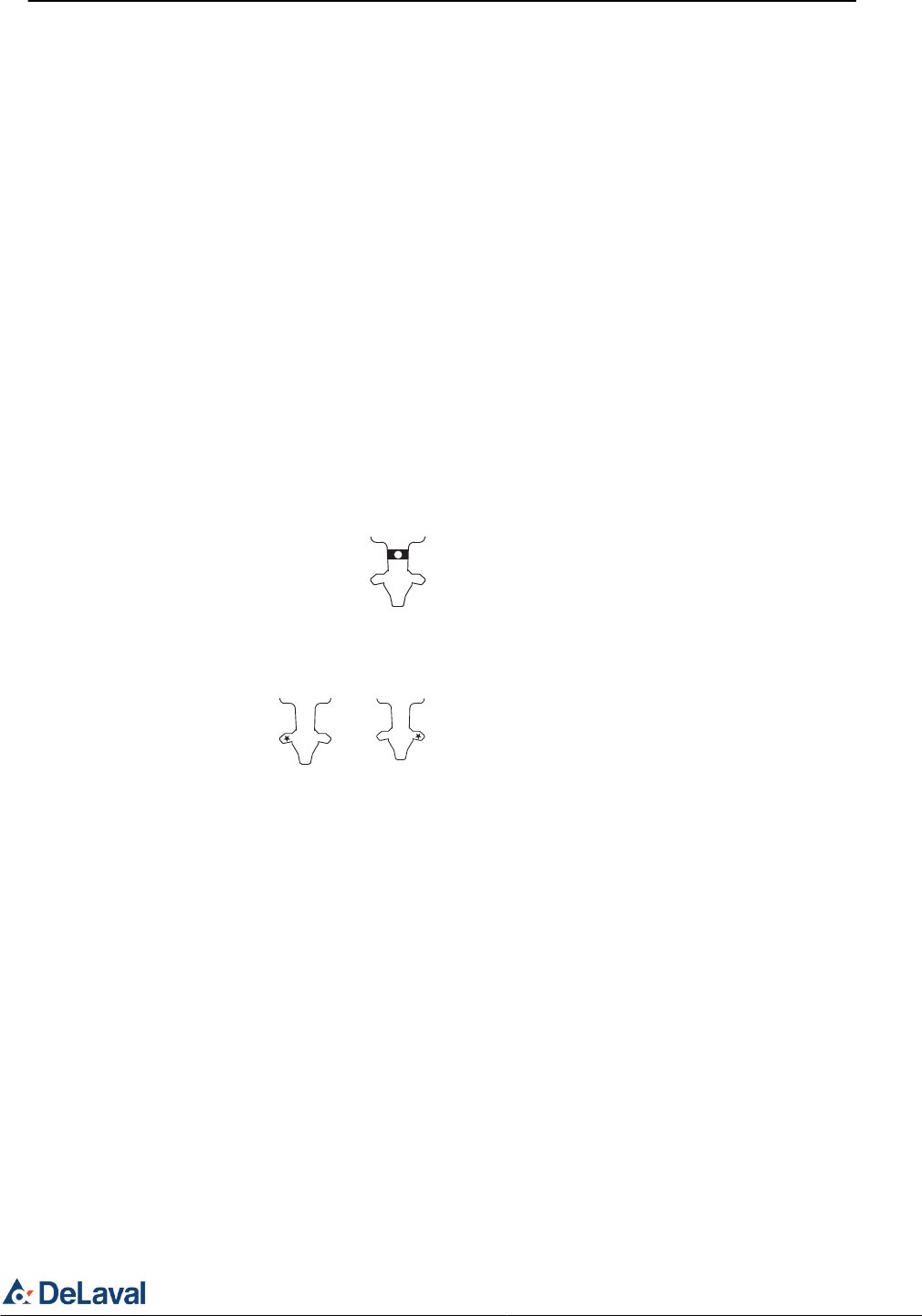
Preliminary
941322_VMS Instruction Book 2006.pdf2009-09-07
No. Name Range Default Description/optionsNo. Name Range Default Description/options
0 = no acidic cleaning0 = no acidic cleaning
1 = one alkaline, one acidic cleaning1 = one alkaline, one acidic cleaning
2 = two alkaline, one acidic cleaning2 = two alkaline, one acidic cleaning
3 = etc.3 = etc.
Maintenance an calibration
The following points are important to sustain
correct dosing of etergents. Note that
these two tasks should be performed by an
authorised DeLaval service engineer.
•The tubes in the peristaltic pumps should
be replaced at least two times a year.
•The dosing volume (P6-P8) of the
detergent pumps should be checked
every third month. The dosing capacity
(P32-P34) may need to be adjusted.
Starting cleaning or rinsing
from the touch screen
Note: Any ongoing backflush process must
first be finished before cleaning or rinsing
can be started.
1. Ensure that the milking station is in
manual mode.
2. Remove any cow that might be in the
milking station.
After treatment window
Note: Both gates should be closed to
prevent a cow from entering before the
system cleaning has been started. Closing
and opening gates is done in the Stall
control window.
3. Press the tab After Treatment on the
touch screen to display the After treatment
window.
4. In the After treatment window, press the
Cleaning and Rinsing button. This will open
the Cleaning and rinsing window.
nNo electric wires with more than 30 V running
close to the ID readers. Separation distance
at least 1.5 meter and 2-3 meters is preferred.
nElectric fence type cow trainers must not be
used in the parlor and holding area.
2 Introduction
An advanced technical system used for cow iden-
tification requires three components:
nTransponders
nWalk-by antenna
nCow place antennas
2.1 Transponders
DeLaval multi ID system support cow identifica-
tion by means of B-transponder and ISO HDX/
FDX transponder.
Note! If no other considerations need to be
taken, United States Animal Identification Plan
(USAIP) and National Cattlemen’s Beef Associ-
ation (NCBA) are recommending left ear, as the
first hand choice, for ISO HDX/FDX transponder
location.
2.2 Walk-by antennas
The walk-by antenna is located in the entrance
gate. DeLaval multi ID system support the ID
reader walk by (IRW). The IRW replaced Blue
Curtain and Multi reader in July 2014.
210205
Fig. 1: B-transponder carried on the neckband
210206
Fig. 2: ISO HDX/FDX transponder in the cow’s ear
(left or right)
DeLaval Champion ID
General description
© DeLaval 2016.
2016-09-14, Version 9 10 (24) 85417601
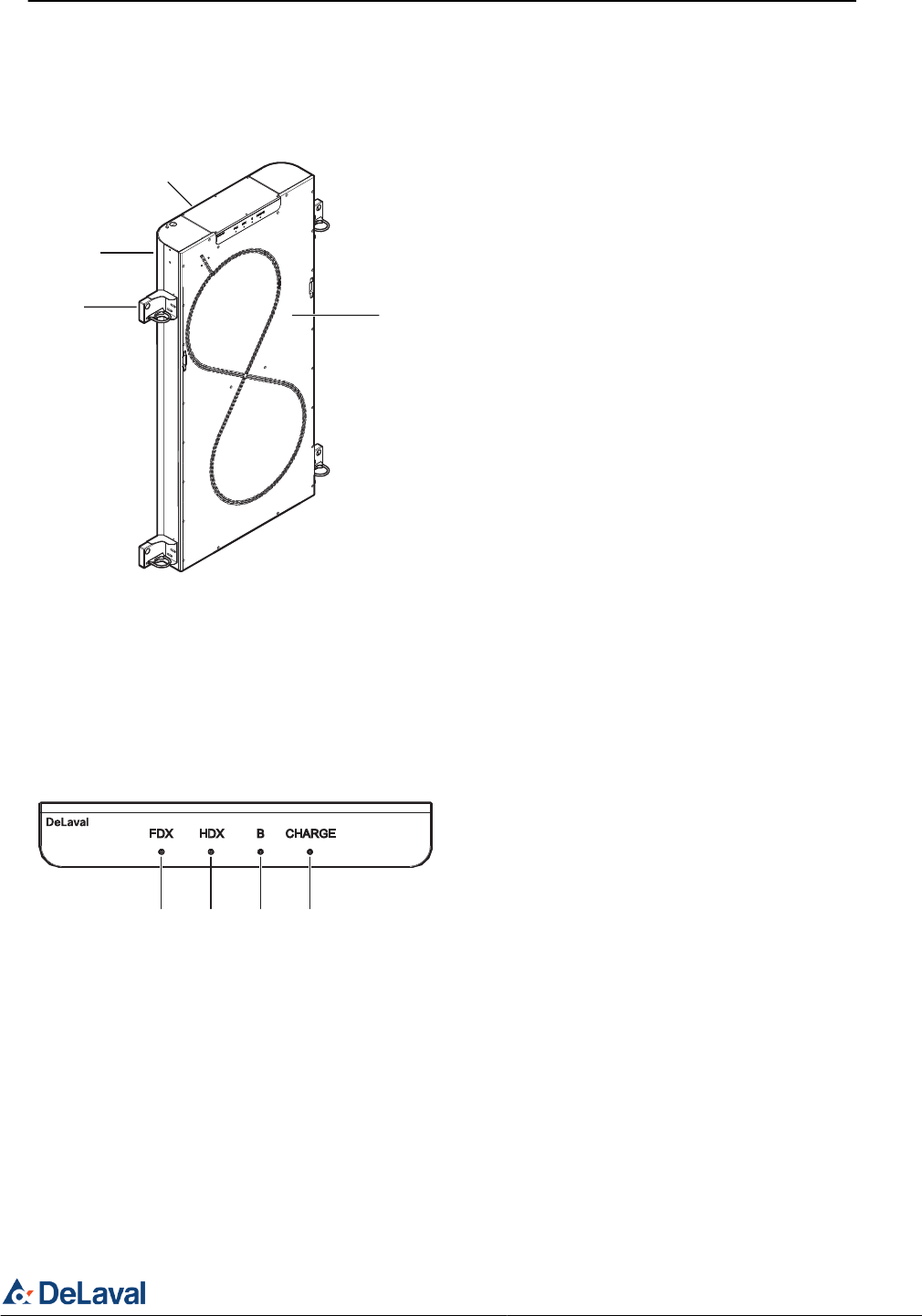
Preliminary
941322_VMS Instruction Book 2006.pdf2009-09-07
No. Name Range Default Description/optionsNo. Name Range Default Description/options
0 = no acidic cleaning0 = no acidic cleaning
1 = one alkaline, one acidic cleaning1 = one alkaline, one acidic cleaning
2 = two alkaline, one acidic cleaning2 = two alkaline, one acidic cleaning
3 = etc.3 = etc.
Maintenance an calibration
The following points are important to sustain
correct dosing of etergents. Note that
these two tasks should be performed by an
authorised DeLaval service engineer.
•The tubes in the peristaltic pumps should
be replaced at least two times a year.
•The dosing volume (P6-P8) of the
detergent pumps should be checked
every third month. The dosing capacity
(P32-P34) may need to be adjusted.
Starting cleaning or rinsing
from the touch screen
Note: Any ongoing backflush process must
first be finished before cleaning or rinsing
can be started.
1. Ensure that the milking station is in
manual mode.
2. Remove any cow that might be in the
milking station.
After treatment window
Note: Both gates should be closed to
prevent a cow from entering before the
system cleaning has been started. Closing
and opening gates is done in the Stall
control window.
3. Press the tab After Treatment on the
touch screen to display the After treatment
window.
4. In the After treatment window, press the
Cleaning and Rinsing button. This will open
the Cleaning and rinsing window.
2.2.1 ID reader walk by (IRW)
2.2.1.1 Introduction
The IRW is used to identify cows with B-trans-
ponders or ISO HDX/FDX transponders.
D
B
C
A
232466
Fig. 3: IRW.
A: Antenna panel
B: Support brackets with lifting eyes
C: Galvanized steel stand
D: Electronic box
A B C D
232477
Fig. 4: LEDs of the IRW electronic box.
A ("FDX"): Light when an FDX transponder is
read
B ("HDX"): Light when an HDX transponder is
read
C ("B"): Light when a B transponder is read
D ("Charge"): Flashing when sending information
DeLaval Champion ID
General description
© DeLaval 2016.
2016-09-14, Version 9 11 (24) 85417601
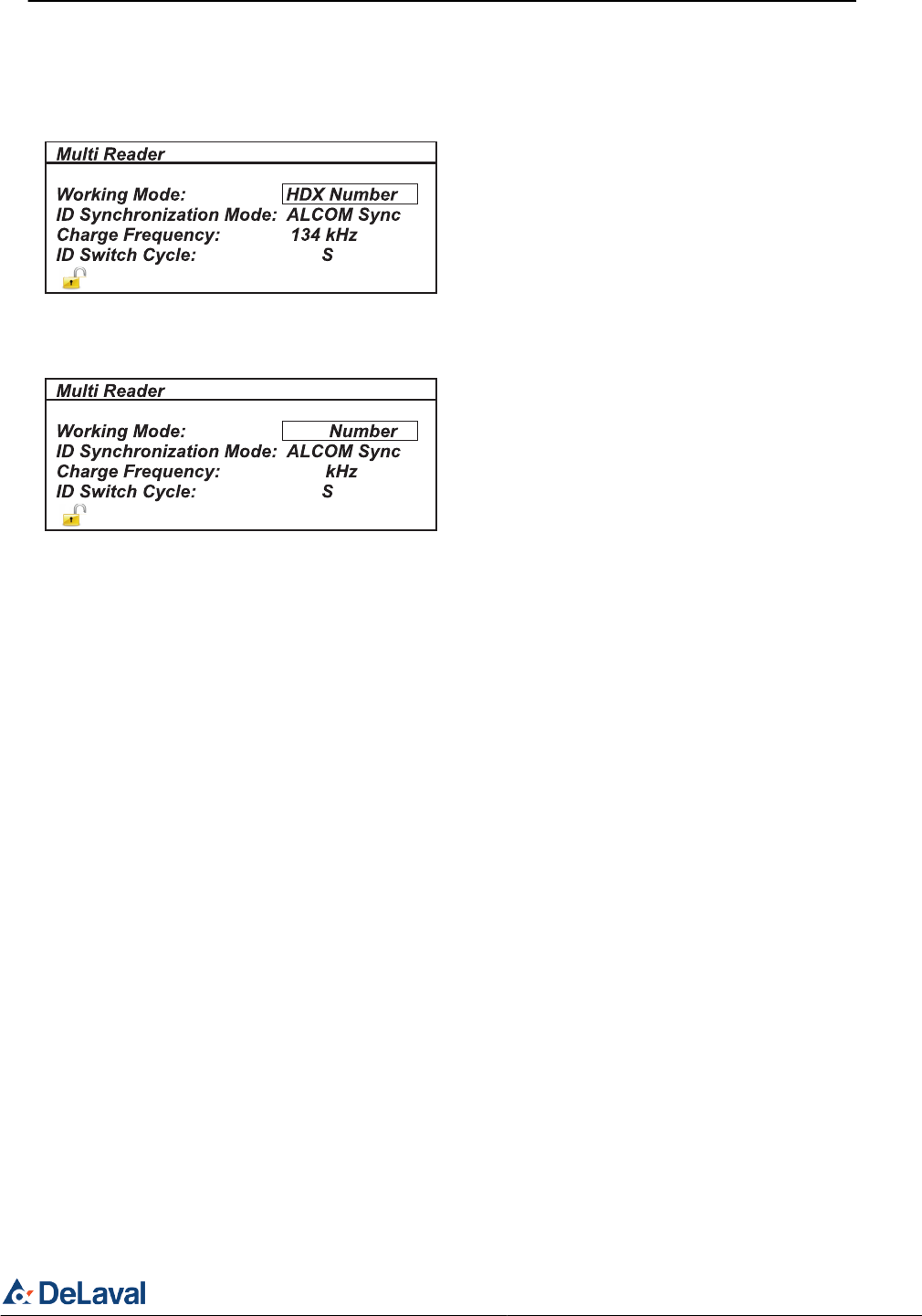
Preliminary
941322_VMS Instruction Book 2006.pdf2009-09-07
No. Name Range Default Description/optionsNo. Name Range Default Description/options
0 = no acidic cleaning0 = no acidic cleaning
1 = one alkaline, one acidic cleaning1 = one alkaline, one acidic cleaning
2 = two alkaline, one acidic cleaning2 = two alkaline, one acidic cleaning
3 = etc.3 = etc.
Maintenance an calibration
The following points are important to sustain
correct dosing of etergents. Note that
these two tasks should be performed by an
authorised DeLaval service engineer.
•The tubes in the peristaltic pumps should
be replaced at least two times a year.
•The dosing volume (P6-P8) of the
detergent pumps should be checked
every third month. The dosing capacity
(P32-P34) may need to be adjusted.
Starting cleaning or rinsing
from the touch screen
Note: Any ongoing backflush process must
first be finished before cleaning or rinsing
can be started.
1. Ensure that the milking station is in
manual mode.
2. Remove any cow that might be in the
milking station.
After treatment window
Note: Both gates should be closed to
prevent a cow from entering before the
system cleaning has been started. Closing
and opening gates is done in the Stall
control window.
3. Press the tab After Treatment on the
touch screen to display the After treatment
window.
4. In the After treatment window, press the
Cleaning and Rinsing button. This will open
the Cleaning and rinsing window.
2.2.2 IRW function
6:3:8 Multi Reader
The IRW can read B-transponders and ISO
transponders. It can not read both B and ISO at
the same time.
nWorking Mode
– Reduced Number: reads B-transponders
– HDX Numbers: reads ISO transponders
nID Synchronization Mode
– ALCOM Sync: The processor will syn-
chronize all units connected to the pro-
cessor
– Wire Sync: One reader synchronizes all
IRWs connected to the IRW that is the
master in the system, connected with a
wire between the units. This option can
be used when more than one processor
is used
nCharge Frequency
– 131 KhZ: for B-transponders
– 134 kHz: for ISO transponders
nID Switch Cycle
– 10 S: for B-transponders
– 10 S: for ISO transponders
2.3 Cow place antennas
2.3.1 In Place Reader
The cow place antenna, the IPR is located inside
the parlour.
The IPR is an electronic unit that is used to iden-
tify animals wearing ISO ear or B-transponders.
This type of identification is used in parlour appli-
cations where the animals identity determines
the action that should be carried out by the sys-
tem.
When an ear or B-transponder is within the scan-
ning area of the reader, the reader will send the
scanned date to a receiver unit for example sta-
tion controller. The data is processed by the
receiving unit and the programmed action.
10
10
RED
131
210209
Fig. 5
DeLaval Champion ID
General description
© DeLaval 2016.
2016-09-14, Version 9 12 (24) 85417601

Preliminary
941322_VMS Instruction Book 2006.pdf2009-09-07
No. Name Range Default Description/optionsNo. Name Range Default Description/options
0 = no acidic cleaning0 = no acidic cleaning
1 = one alkaline, one acidic cleaning1 = one alkaline, one acidic cleaning
2 = two alkaline, one acidic cleaning2 = two alkaline, one acidic cleaning
3 = etc.3 = etc.
Maintenance an calibration
The following points are important to sustain
correct dosing of etergents. Note that
these two tasks should be performed by an
authorised DeLaval service engineer.
•The tubes in the peristaltic pumps should
be replaced at least two times a year.
•The dosing volume (P6-P8) of the
detergent pumps should be checked
every third month. The dosing capacity
(P32-P34) may need to be adjusted.
Starting cleaning or rinsing
from the touch screen
Note: Any ongoing backflush process must
first be finished before cleaning or rinsing
can be started.
1. Ensure that the milking station is in
manual mode.
2. Remove any cow that might be in the
milking station.
After treatment window
Note: Both gates should be closed to
prevent a cow from entering before the
system cleaning has been started. Closing
and opening gates is done in the Stall
control window.
3. Press the tab After Treatment on the
touch screen to display the After treatment
window.
4. In the After treatment window, press the
Cleaning and Rinsing button. This will open
the Cleaning and rinsing window.
2.3.2 Positioning of readers
nISO transponders: Position the readers in the
high position as described
nB-transponders: Position the readers as low
as possible, but avoid positioning the bracket
so low that it sticks out, causing injuries to the
cow
2.3.3 ID information processing
When a cow is identified by the IRW, her trans-
ponder number is compared with her cow num-
ber, kept in the memory.
All transponder numbers are stored in a buffer as
an array. From the buffer the processor send out
the cow numbers to the MPCs according to the
order in which they were identified.
2.3.3.1 Function of in place reader on the first place
Sometimes the entrance gate opens and the
information (regarding ID numbers made by the
IRW) is erased from the buffer. For this purpose,
DeLaval offers the solution "Identification and
Correction", giving the second chance to identify
the first cow in the batch, with help of the in place
reader, positioned on the first place (FPR= First
place reader).
Note! The in place reader must be installed in a
place where 100% accuracy can be ensured
about which cow is rated as the "first" cow.
DeLaval Champion ID
General description
© DeLaval 2016.
2016-09-14, Version 9 13 (24) 85417601
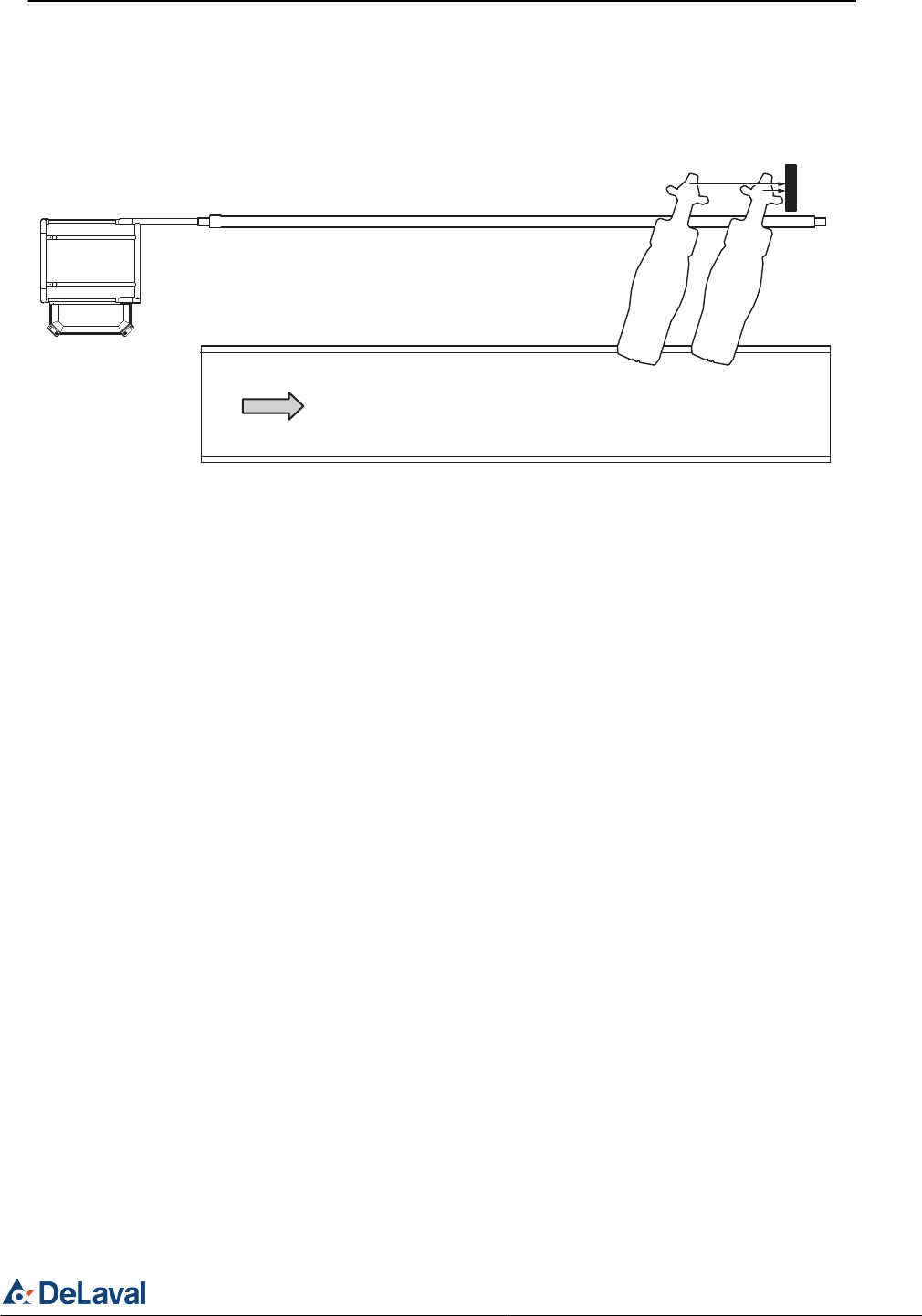
Preliminary
941322_VMS Instruction Book 2006.pdf2009-09-07
No. Name Range Default Description/optionsNo. Name Range Default Description/options
0 = no acidic cleaning0 = no acidic cleaning
1 = one alkaline, one acidic cleaning1 = one alkaline, one acidic cleaning
2 = two alkaline, one acidic cleaning2 = two alkaline, one acidic cleaning
3 = etc.3 = etc.
Maintenance an calibration
The following points are important to sustain
correct dosing of etergents. Note that
these two tasks should be performed by an
authorised DeLaval service engineer.
•The tubes in the peristaltic pumps should
be replaced at least two times a year.
•The dosing volume (P6-P8) of the
detergent pumps should be checked
every third month. The dosing capacity
(P32-P34) may need to be adjusted.
Starting cleaning or rinsing
from the touch screen
Note: Any ongoing backflush process must
first be finished before cleaning or rinsing
can be started.
1. Ensure that the milking station is in
manual mode.
2. Remove any cow that might be in the
milking station.
After treatment window
Note: Both gates should be closed to
prevent a cow from entering before the
system cleaning has been started. Closing
and opening gates is done in the Stall
control window.
3. Press the tab After Treatment on the
touch screen to display the After treatment
window.
4. In the After treatment window, press the
Cleaning and Rinsing button. This will open
the Cleaning and rinsing window.
C
A
B
D
210212
Fig. 6: In place reader on the first place
A: Entrance
B: IRW
C: FPR
D: Exit
2.3.3.2 Function of in place reader on the last place
The accuracy of readings can be improved with
the in place reader located on the last place (LPR
= last place reader). This solution is known as ID
verification.
With the first cow identified by the IRW or by the
FPR, the ID verification of the entire batch (row
or gang of cows), can be completed due to the
way the information is handled by the software.
The batch is represented in the software as an
array containing ID numbers. In this array the
FPR is considered to be equivalent with
"START reading", while the LPR is considered to
be "STOP reading". All other readings will be sor-
ted in-between these two determinations.
DeLaval Champion ID
General description
© DeLaval 2016.
2016-09-14, Version 9 14 (24) 85417601
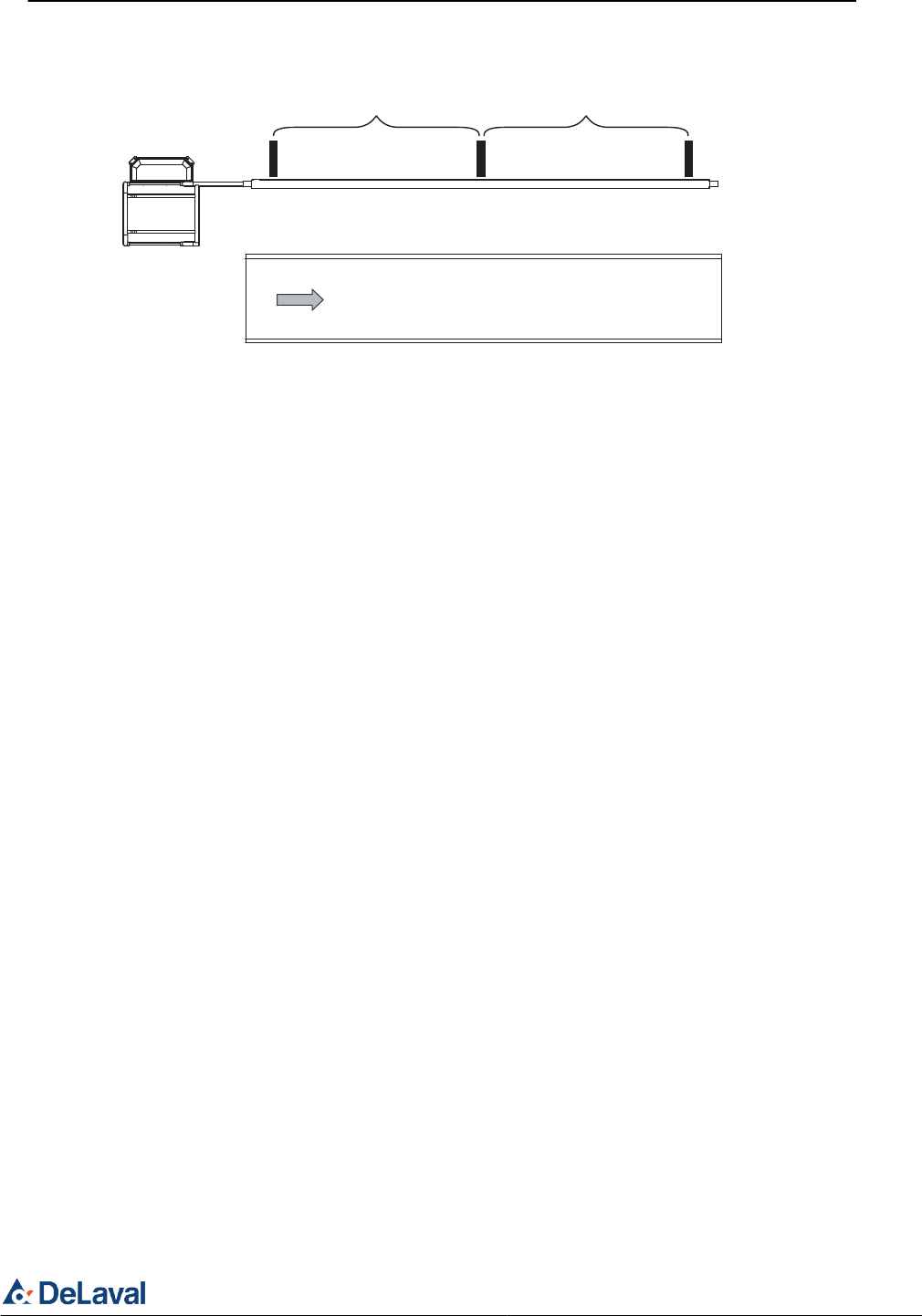
Preliminary
941322_VMS Instruction Book 2006.pdf2009-09-07
No. Name Range Default Description/optionsNo. Name Range Default Description/options
0 = no acidic cleaning0 = no acidic cleaning
1 = one alkaline, one acidic cleaning1 = one alkaline, one acidic cleaning
2 = two alkaline, one acidic cleaning2 = two alkaline, one acidic cleaning
3 = etc.3 = etc.
Maintenance an calibration
The following points are important to sustain
correct dosing of etergents. Note that
these two tasks should be performed by an
authorised DeLaval service engineer.
•The tubes in the peristaltic pumps should
be replaced at least two times a year.
•The dosing volume (P6-P8) of the
detergent pumps should be checked
every third month. The dosing capacity
(P32-P34) may need to be adjusted.
Starting cleaning or rinsing
from the touch screen
Note: Any ongoing backflush process must
first be finished before cleaning or rinsing
can be started.
1. Ensure that the milking station is in
manual mode.
2. Remove any cow that might be in the
milking station.
After treatment window
Note: Both gates should be closed to
prevent a cow from entering before the
system cleaning has been started. Closing
and opening gates is done in the Stall
control window.
3. Press the tab After Treatment on the
touch screen to display the After treatment
window.
4. In the After treatment window, press the
Cleaning and Rinsing button. This will open
the Cleaning and rinsing window.
LPR1 FPR1LPR2
GANG 2 GANG 1
5
7
6
210213
Fig. 7: In place reader on the last place
5: IRW
6: Exit
7 : Entrance
2.3.3.3 Function of in place reader for in-place ID
The accuracy of readings can be improved even
more with in-place ID. This means that a in place
reader is located on each cow place. Each cow
is specifically identified on each place. This sol-
ution makes the IRW redundant.
2.3.3.4 Function of in place reader for in place ID Par-
allel parlours
When the entrance gate opens, the readers on
the first and third stall are activated. When the
first reader has read a transponder, the second
and the fourth readers are activated. When the
second cow is identified, the third and the fifty
readers are activated and the first cow is verified
and so on. When a cow is verified the reader is
turned off.
If there is a cow without transponder or missed,
the MPC will show ------.
A cow can be identified by more than one reader
and then the ALPRO logic finds out where she is.
When the exit gate or gang fronts are opened, the
milk weight is confirmed to the processor. When
the first cow in the next batch of cows is identified,
the milk meters are reset and the old cow num-
bers disappears.
DeLaval Champion ID
General description
© DeLaval 2016.
2016-09-14, Version 9 15 (24) 85417601
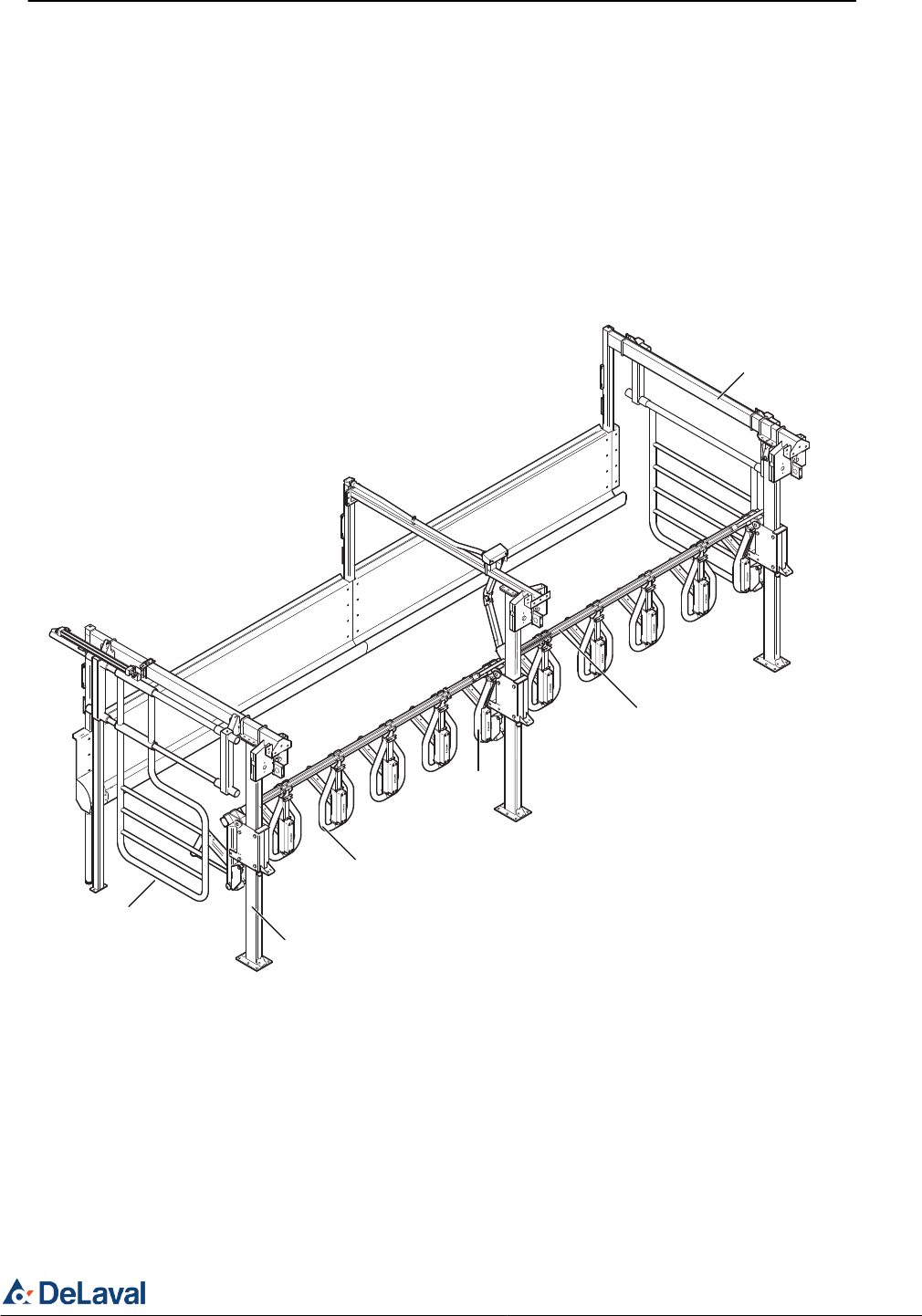
Preliminary
941322_VMS Instruction Book 2006.pdf2009-09-07
No. Name Range Default Description/optionsNo. Name Range Default Description/options
0 = no acidic cleaning0 = no acidic cleaning
1 = one alkaline, one acidic cleaning1 = one alkaline, one acidic cleaning
2 = two alkaline, one acidic cleaning2 = two alkaline, one acidic cleaning
3 = etc.3 = etc.
Maintenance an calibration
The following points are important to sustain
correct dosing of etergents. Note that
these two tasks should be performed by an
authorised DeLaval service engineer.
•The tubes in the peristaltic pumps should
be replaced at least two times a year.
•The dosing volume (P6-P8) of the
detergent pumps should be checked
every third month. The dosing capacity
(P32-P34) may need to be adjusted.
Starting cleaning or rinsing
from the touch screen
Note: Any ongoing backflush process must
first be finished before cleaning or rinsing
can be started.
1. Ensure that the milking station is in
manual mode.
2. Remove any cow that might be in the
milking station.
After treatment window
Note: Both gates should be closed to
prevent a cow from entering before the
system cleaning has been started. Closing
and opening gates is done in the Stall
control window.
3. Press the tab After Treatment on the
touch screen to display the After treatment
window.
4. In the After treatment window, press the
Cleaning and Rinsing button. This will open
the Cleaning and rinsing window.
3 Parlour applications
The DeLaval multi ID system is applicable for
both parallel and herringbone parlours. The ID
components are the same for all applications.
4 Main parts
E
A
B
C
F
D
210222
Fig. 8
A: Arch
B: Entrance gate
C: Column
D: Milk bottle
E: Intermediate milk bottle and blocker
F: Neck rail
DeLaval Champion ID
General description
© DeLaval 2016.
2016-09-14, Version 9 16 (24) 85417601

Preliminary
941322_VMS Instruction Book 2006.pdf2009-09-07
No. Name Range Default Description/optionsNo. Name Range Default Description/options
0 = no acidic cleaning0 = no acidic cleaning
1 = one alkaline, one acidic cleaning1 = one alkaline, one acidic cleaning
2 = two alkaline, one acidic cleaning2 = two alkaline, one acidic cleaning
3 = etc.3 = etc.
Maintenance an calibration
The following points are important to sustain
correct dosing of etergents. Note that
these two tasks should be performed by an
authorised DeLaval service engineer.
•The tubes in the peristaltic pumps should
be replaced at least two times a year.
•The dosing volume (P6-P8) of the
detergent pumps should be checked
every third month. The dosing capacity
(P32-P34) may need to be adjusted.
Starting cleaning or rinsing
from the touch screen
Note: Any ongoing backflush process must
first be finished before cleaning or rinsing
can be started.
1. Ensure that the milking station is in
manual mode.
2. Remove any cow that might be in the
milking station.
After treatment window
Note: Both gates should be closed to
prevent a cow from entering before the
system cleaning has been started. Closing
and opening gates is done in the Stall
control window.
3. Press the tab After Treatment on the
touch screen to display the After treatment
window.
4. In the After treatment window, press the
Cleaning and Rinsing button. This will open
the Cleaning and rinsing window.
Operator's maintenance
DeLaval Champion ID
1 Daily maintenance
The IRW antenna should be kept clean using
only water.
Check that the cable routings from the reader to
the MPC are intact. Correct if necessary.
2 Yearly maintenance
Check that all screws and bolts are tightened.
DeLaval Champion ID
Operator's maintenance
© DeLaval 2016.
2016-09-14, Version 9 17 (24) 85417601
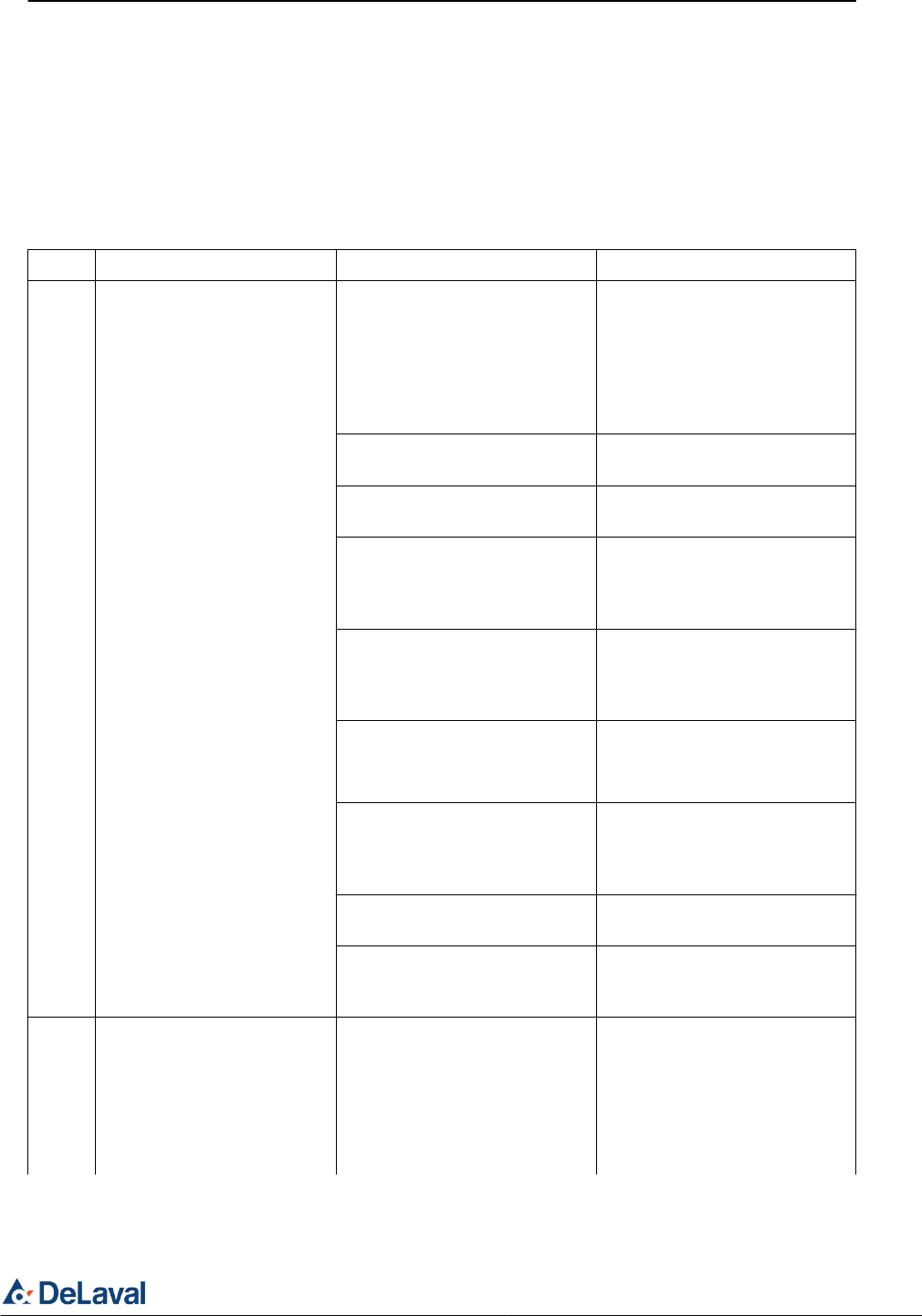
Preliminary
941322_VMS Instruction Book 2006.pdf2009-09-07
No. Name Range Default Description/optionsNo. Name Range Default Description/options
0 = no acidic cleaning0 = no acidic cleaning
1 = one alkaline, one acidic cleaning1 = one alkaline, one acidic cleaning
2 = two alkaline, one acidic cleaning2 = two alkaline, one acidic cleaning
3 = etc.3 = etc.
Maintenance an calibration
The following points are important to sustain
correct dosing of etergents. Note that
these two tasks should be performed by an
authorised DeLaval service engineer.
•The tubes in the peristaltic pumps should
be replaced at least two times a year.
•The dosing volume (P6-P8) of the
detergent pumps should be checked
every third month. The dosing capacity
(P32-P34) may need to be adjusted.
Starting cleaning or rinsing
from the touch screen
Note: Any ongoing backflush process must
first be finished before cleaning or rinsing
can be started.
1. Ensure that the milking station is in
manual mode.
2. Remove any cow that might be in the
milking station.
After treatment window
Note: Both gates should be closed to
prevent a cow from entering before the
system cleaning has been started. Closing
and opening gates is done in the Stall
control window.
3. Press the tab After Treatment on the
touch screen to display the After treatment
window.
4. In the After treatment window, press the
Cleaning and Rinsing button. This will open
the Cleaning and rinsing window.
Troubleshooting
DeLaval Champion ID
1 Troubleshooting
No. Symptom Cause Action
1 Wrong ID or missed ID. Low
hit rate
More than one cow in front of
the antenna
Narrow and/or extend the lane
in front of the antenna
Use archway to prevent cows
from riding in the lane
Check that no steelwork is
missing or deformed
Transponders not functioning Exchange broken or weak
transponders
Transponder in the wrong side Move the transponder to the
correct side
Wrongly connected switch Connect the switch correctly. It
is important to get a correct sig-
nal, "open" when open and
"closed" when closed
The cables to the IRW
(12 VAC, ALCOM and Gate
switch wire) should not be
inside the antenna
The cables should go through
the grommets and then follow
steelworks or frameworks in
the parlour
Problems with ALCOM com-
munication
Check ALCOM settings
Check that the ALCOM bus is
connected
Antenna terminals should
always be properly connected
and have a clean surface
against board terminals
Broken antenna Contact the local dealer or
service man
Problems with the IRW soft-
ware
Contact the local dealer or
service man for service or
replacement
2 Missed ID when cows are
entering
Interference from frequency
converter (especially in Rotary)
Follow the assembly instruc-
tions for frequency converter.
Use shielded wires
Check with the frequency con-
verter supplier how to achieve
efficient interference suppres-
sion
» Continue next page
DeLaval Champion ID
Troubleshooting
© DeLaval 2016.
2016-09-14, Version 9 18 (24) 85417601
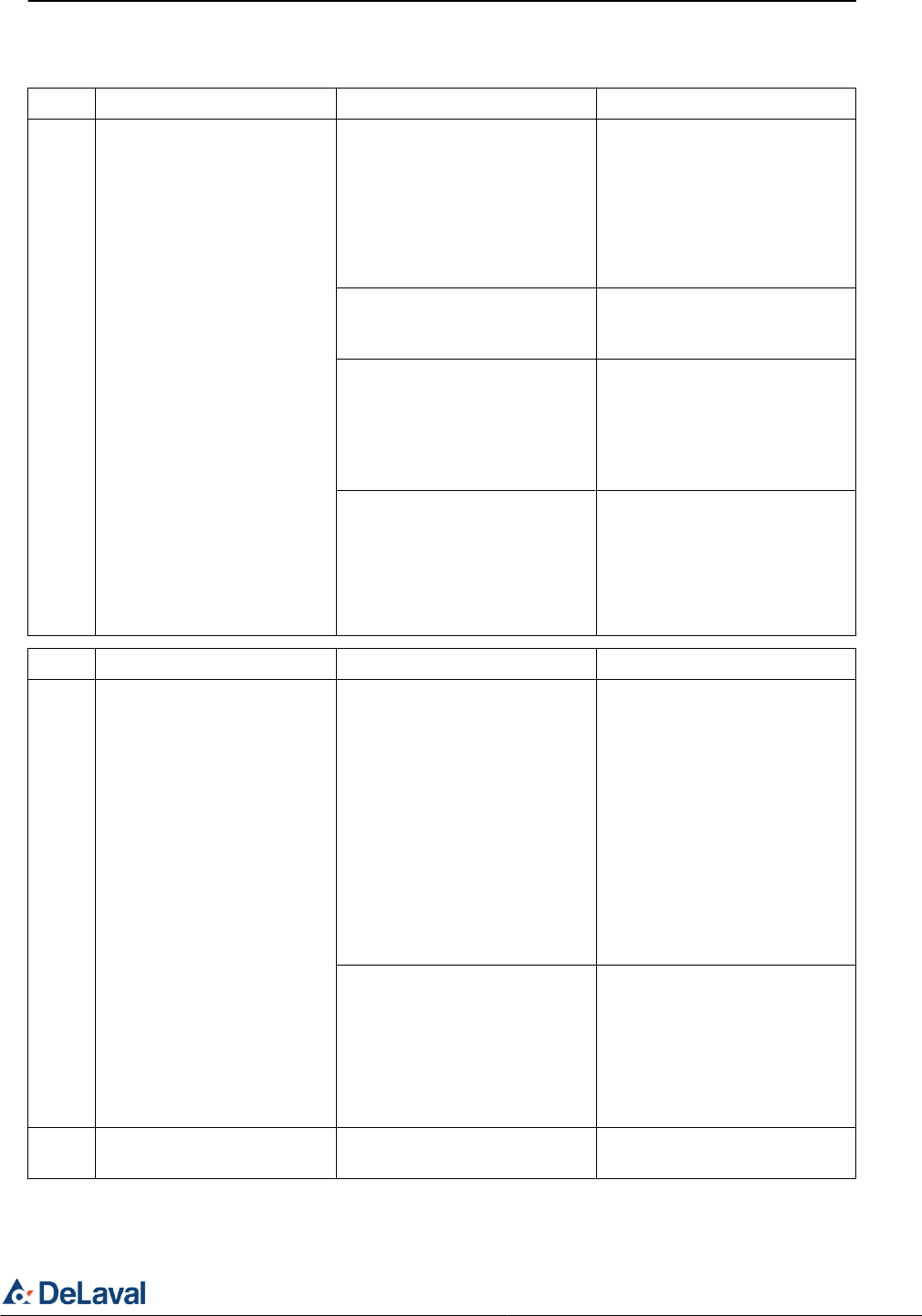
Preliminary
941322_VMS Instruction Book 2006.pdf2009-09-07
No. Name Range Default Description/optionsNo. Name Range Default Description/options
0 = no acidic cleaning0 = no acidic cleaning
1 = one alkaline, one acidic cleaning1 = one alkaline, one acidic cleaning
2 = two alkaline, one acidic cleaning2 = two alkaline, one acidic cleaning
3 = etc.3 = etc.
Maintenance an calibration
The following points are important to sustain
correct dosing of etergents. Note that
these two tasks should be performed by an
authorised DeLaval service engineer.
•The tubes in the peristaltic pumps should
be replaced at least two times a year.
•The dosing volume (P6-P8) of the
detergent pumps should be checked
every third month. The dosing capacity
(P32-P34) may need to be adjusted.
Starting cleaning or rinsing
from the touch screen
Note: Any ongoing backflush process must
first be finished before cleaning or rinsing
can be started.
1. Ensure that the milking station is in
manual mode.
2. Remove any cow that might be in the
milking station.
After treatment window
Note: Both gates should be closed to
prevent a cow from entering before the
system cleaning has been started. Closing
and opening gates is done in the Stall
control window.
3. Press the tab After Treatment on the
touch screen to display the After treatment
window.
4. In the After treatment window, press the
Cleaning and Rinsing button. This will open
the Cleaning and rinsing window.
No. Symptom Cause Action
Use a filter on the cable
Place the frequency converter
as far away as possible from
the antenna
Do not install the frequency
converter in the same cable
duct as the antenna
Input voltage below 12 VAC
-10%
Make sure the input voltage is
within tolerance, 12 VAC
+20%, -10%
Disturbance from:
– computer screens
– mobile telephone charger, or
– other electronics
(See actions above.) Use fil-
ters, keep long distance
between the antenna and the
noise source, do not install on
the same cable and use shiel-
ded wiring
Antenna mounted to close to:
– calf feeder (minimum 30 m)
– any none synchronized ID
equipment, or
– long wave radio transmitter
Increase the distance between
noise source and antenna
No. Symptom Cause Action
3 IRW is not connected to
ALPRO
Check ALPRO menu 6.8.1 to
see node status
The symbol * shows that a
node is connected to the bus
and correctly configured in
ALPRO
x shows that the IRW not is
connected to the bus but cor-
rectly configured in ALPRO
+ shows that the IRW is con-
nected to the bus but not cor-
rect configured in ALPRO
Check node address settings
on the IRW
Check that the ALCOM bus
wire is connected to pin 1 and
2 or 3 and 4
Check that the ALCOM bus
wire has proper connection to
ALPRO
Make sure that the Power LED
on the IRW is on.
ALPRO menu 6.8.1, node sta-
tus, indicates that the IRW is
not connected to ALPRO at all
times. The symbols are chang-
ing between * and x
All nodes on the network must
have correct ALCOM address
Check that all other nodes are
working properly. If another
node is broken, this might
cause communication prob-
lems on the bus
4 Power LED on the IRW is off Power supply off Check that 12 VAC is connec-
ted between pin 27 and 28
DeLaval Champion ID
Troubleshooting
© DeLaval 2016.
2016-09-14, Version 9 19 (24) 85417601
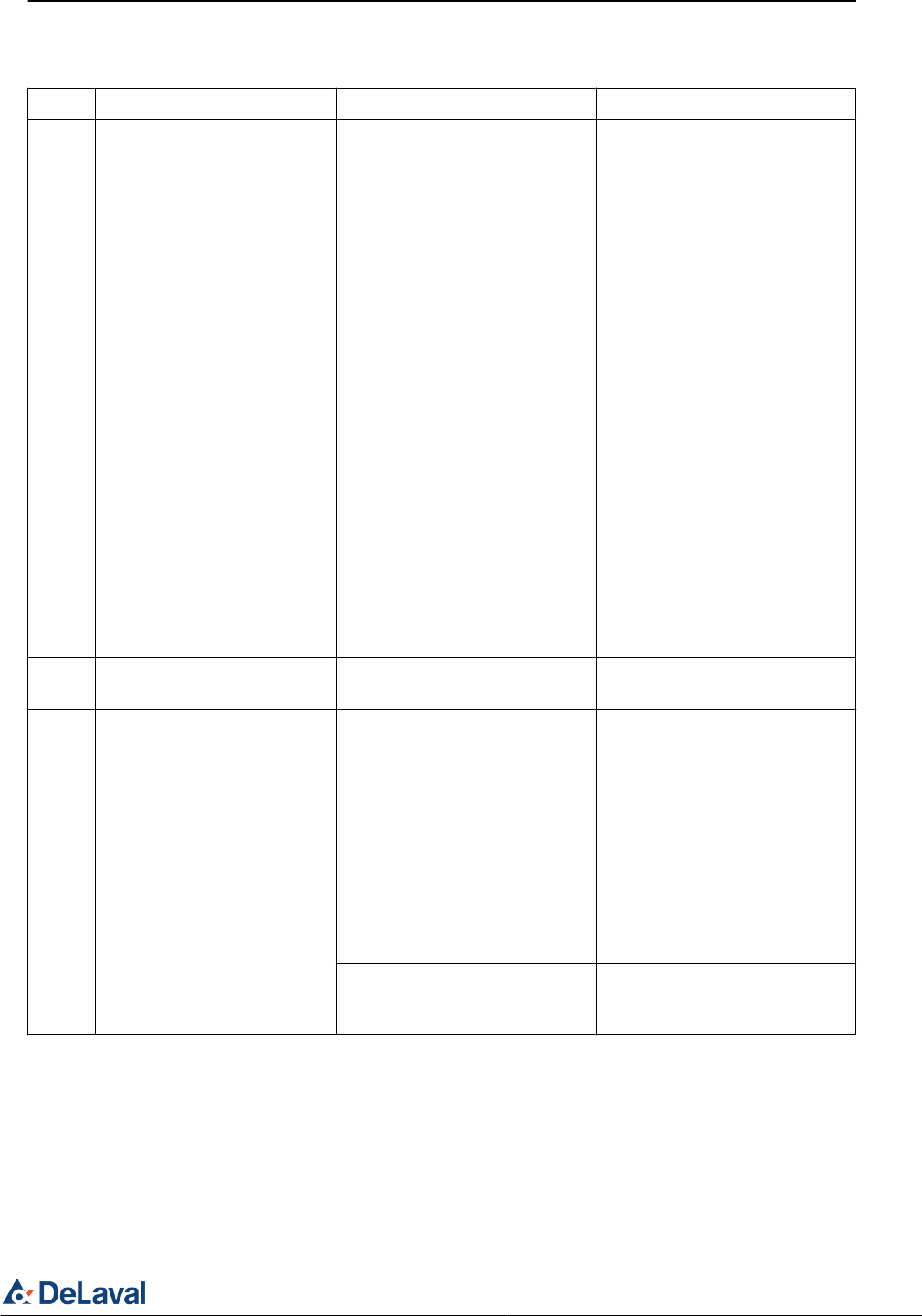
Preliminary
941322_VMS Instruction Book 2006.pdf2009-09-07
No. Name Range Default Description/optionsNo. Name Range Default Description/options
0 = no acidic cleaning0 = no acidic cleaning
1 = one alkaline, one acidic cleaning1 = one alkaline, one acidic cleaning
2 = two alkaline, one acidic cleaning2 = two alkaline, one acidic cleaning
3 = etc.3 = etc.
Maintenance an calibration
The following points are important to sustain
correct dosing of etergents. Note that
these two tasks should be performed by an
authorised DeLaval service engineer.
•The tubes in the peristaltic pumps should
be replaced at least two times a year.
•The dosing volume (P6-P8) of the
detergent pumps should be checked
every third month. The dosing capacity
(P32-P34) may need to be adjusted.
Starting cleaning or rinsing
from the touch screen
Note: Any ongoing backflush process must
first be finished before cleaning or rinsing
can be started.
1. Ensure that the milking station is in
manual mode.
2. Remove any cow that might be in the
milking station.
After treatment window
Note: Both gates should be closed to
prevent a cow from entering before the
system cleaning has been started. Closing
and opening gates is done in the Stall
control window.
3. Press the tab After Treatment on the
touch screen to display the After treatment
window.
4. In the After treatment window, press the
Cleaning and Rinsing button. This will open
the Cleaning and rinsing window.
No. Symptom Cause Action
5 Cow ID does not appear on
MPC at all when cows are
entering the parlour
Communication problem Check the ALCOM bus con-
nection on IRW
Make sure the Power LED is on
Make sure that the transponder
activation LED on the IRW is
flashing when cows are pass-
ing
Check that the IRW is correctly
configured in ALPRO
Check that the Gate switch
connects pin 22 and 23 on the
IRW connections when the
entrance gate is open
Pin 22 is ground and pin 23
should be between 12 to
15 VDC when the gate is
closed. When the gate is open,
the Gate switch should short
circuit pin 22 and 23. Voltage
on pin 23 should then be 0 V
If no Gate switch is installed,
pin 22 and 23 should be short
circuit with a wire
6 Cow ID is erased from MPC
before the parlour is full
Check that the Exit gate switch
is operating correctly
7 Antenna tuning indicates a
problem
The antenna has too low induc-
tance. The three lowest LEDs
will flash for 10 seconds
If steelwork are assembled
onto the antenna after installa-
tion, this might reduce perform-
ance
Check that the steelworks is not
deformed and is of galvanized
steel
The width should be 800 mm
and depth 300 mm. If this is
changed during installation,
problems will occur
Antenna has too high induc-
tance. The centre LED will flash
for 10 seconds
Make sure the antenna back
cover is on
DeLaval Champion ID
Troubleshooting
© DeLaval 2016.
2016-09-14, Version 9 20 (24) 85417601
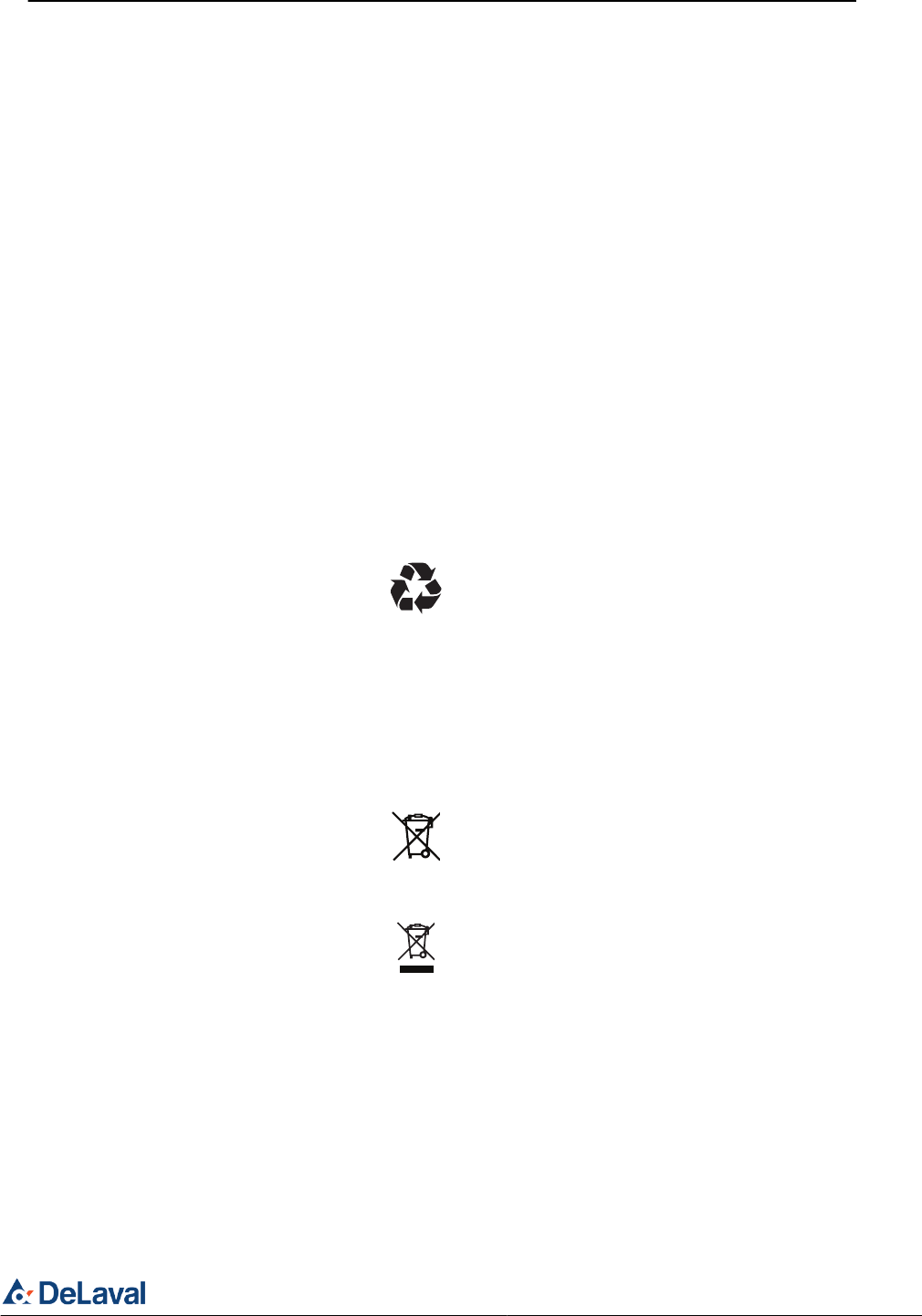
Preliminary
941322_VMS Instruction Book 2006.pdf2009-09-07
No. Name Range Default Description/optionsNo. Name Range Default Description/options
0 = no acidic cleaning0 = no acidic cleaning
1 = one alkaline, one acidic cleaning1 = one alkaline, one acidic cleaning
2 = two alkaline, one acidic cleaning2 = two alkaline, one acidic cleaning
3 = etc.3 = etc.
Maintenance an calibration
The following points are important to sustain
correct dosing of etergents. Note that
these two tasks should be performed by an
authorised DeLaval service engineer.
•The tubes in the peristaltic pumps should
be replaced at least two times a year.
•The dosing volume (P6-P8) of the
detergent pumps should be checked
every third month. The dosing capacity
(P32-P34) may need to be adjusted.
Starting cleaning or rinsing
from the touch screen
Note: Any ongoing backflush process must
first be finished before cleaning or rinsing
can be started.
1. Ensure that the milking station is in
manual mode.
2. Remove any cow that might be in the
milking station.
After treatment window
Note: Both gates should be closed to
prevent a cow from entering before the
system cleaning has been started. Closing
and opening gates is done in the Stall
control window.
3. Press the tab After Treatment on the
touch screen to display the After treatment
window.
4. In the After treatment window, press the
Cleaning and Rinsing button. This will open
the Cleaning and rinsing window.
Disposal
DeLaval Champion ID
1 Disposal and recycling informa-
tion
When the product reaches end of life, dispose it
properly in accordance with local laws and regu-
lations.
1.1 Disposal of packaging material
(Packaging EU Directive 94/62/EC)
This symbol indicates that the product’s packag-
ing material can be recycled.
1.2 Disposal of electrical and electronic
equipment with or without battery.
(WEEE European Directive 2012/19/EU)
(European Battery Directive 2006/66/EC)
These symbols with a crossed-out wheelie bin on
the product or its packaging indicates that the
equipment is electrical waste, with or without bat-
tery, and shall not be disposed of with household
waste.
A horizontal bar beneath the bin means that the
product is manufactured after August 13, 2005.
To prevent inappropriate waste handling of this
product, and its negative consequences on the
environment and human health, all products shall
be disposed of in accordance with local laws and
regulations. Hand it over to an official recycling
facility, or use a battery disposal facility when
available.
Please contact the local municipal office for infor-
mation on the nearest recycling station.
When the product reaches end of life, dispose
it properly in accordance with local laws and
regulations.
DeLaval Champion ID
Disposal
© DeLaval 2016.
2016-09-14, Version 9 21 (24) 85417601

Preliminary
941322_VMS Instruction Book 2006.pdf2009-09-07
No. Name Range Default Description/optionsNo. Name Range Default Description/options
0 = no acidic cleaning0 = no acidic cleaning
1 = one alkaline, one acidic cleaning1 = one alkaline, one acidic cleaning
2 = two alkaline, one acidic cleaning2 = two alkaline, one acidic cleaning
3 = etc.3 = etc.
Maintenance an calibration
The following points are important to sustain
correct dosing of etergents. Note that
these two tasks should be performed by an
authorised DeLaval service engineer.
•The tubes in the peristaltic pumps should
be replaced at least two times a year.
•The dosing volume (P6-P8) of the
detergent pumps should be checked
every third month. The dosing capacity
(P32-P34) may need to be adjusted.
Starting cleaning or rinsing
from the touch screen
Note: Any ongoing backflush process must
first be finished before cleaning or rinsing
can be started.
1. Ensure that the milking station is in
manual mode.
2. Remove any cow that might be in the
milking station.
After treatment window
Note: Both gates should be closed to
prevent a cow from entering before the
system cleaning has been started. Closing
and opening gates is done in the Stall
control window.
3. Press the tab After Treatment on the
touch screen to display the After treatment
window.
4. In the After treatment window, press the
Cleaning and Rinsing button. This will open
the Cleaning and rinsing window.
DeLaval Champion ID
Disposal
© DeLaval 2016.
2016-09-14, Version 9 22 (24) 85417601

Preliminary
941322_VMS Instruction Book 2006.pdf2009-09-07
No. Name Range Default Description/optionsNo. Name Range Default Description/options
0 = no acidic cleaning0 = no acidic cleaning
1 = one alkaline, one acidic cleaning1 = one alkaline, one acidic cleaning
2 = two alkaline, one acidic cleaning2 = two alkaline, one acidic cleaning
3 = etc.3 = etc.
Maintenance an calibration
The following points are important to sustain
correct dosing of etergents. Note that
these two tasks should be performed by an
authorised DeLaval service engineer.
•The tubes in the peristaltic pumps should
be replaced at least two times a year.
•The dosing volume (P6-P8) of the
detergent pumps should be checked
every third month. The dosing capacity
(P32-P34) may need to be adjusted.
Starting cleaning or rinsing
from the touch screen
Note: Any ongoing backflush process must
first be finished before cleaning or rinsing
can be started.
1. Ensure that the milking station is in
manual mode.
2. Remove any cow that might be in the
milking station.
After treatment window
Note: Both gates should be closed to
prevent a cow from entering before the
system cleaning has been started. Closing
and opening gates is done in the Stall
control window.
3. Press the tab After Treatment on the
touch screen to display the After treatment
window.
4. In the After treatment window, press the
Cleaning and Rinsing button. This will open
the Cleaning and rinsing window.
is a registered trademark of Tetra Laval Holdings & Finance S. A. and DeLaval is a registered trade/service
mark of DeLaval Holding AB.
Preliminary
941322_VMS Instruction Book 2006.pdf2009-09-07
No. Name Range Default Description/optionsNo. Name Range Default Description/options
0 = no acidic cleaning0 = no acidic cleaning
1 = one alkaline, one acidic cleaning1 = one alkaline, one acidic cleaning
2 = two alkaline, one acidic cleaning2 = two alkaline, one acidic cleaning
3 = etc.3 = etc.
Maintenance an calibration
The following points are important to sustain
correct dosing of etergents. Note that
these two tasks should be performed by an
authorised DeLaval service engineer.
•The tubes in the peristaltic pumps should
be replaced at least two times a year.
•The dosing volume (P6-P8) of the
detergent pumps should be checked
every third month. The dosing capacity
(P32-P34) may need to be adjusted.
Starting cleaning or rinsing
from the touch screen
Note: Any ongoing backflush process must
first be finished before cleaning or rinsing
can be started.
1. Ensure that the milking station is in
manual mode.
2. Remove any cow that might be in the
milking station.
After treatment window
Note: Both gates should be closed to
prevent a cow from entering before the
system cleaning has been started. Closing
and opening gates is done in the Stall
control window.
3. Press the tab After Treatment on the
touch screen to display the After treatment
window.
4. In the After treatment window, press the
Cleaning and Rinsing button. This will open
the Cleaning and rinsing window.
DeLaval International AB
Box 39
SE-147 21 Tumba
SWEDEN
www.delaval.com